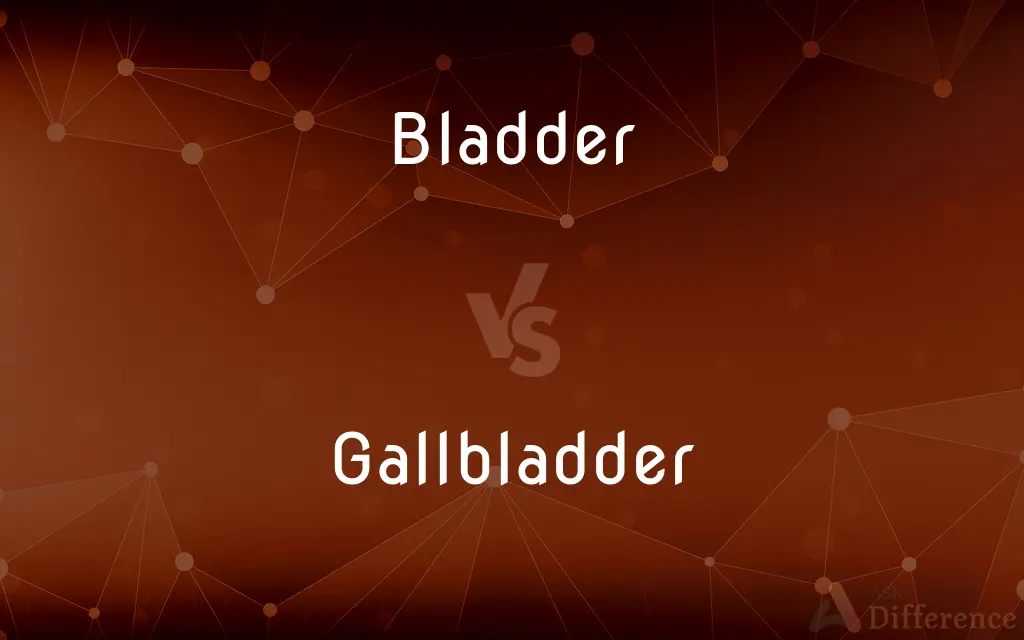Bladder vs. Gallbladder — What's the Difference?
Edited by Tayyaba Rehman — By Fiza Rafique — Updated on September 25, 2023
Bladder is a muscular sac that stores fluids in the body, such as urine. Gallbladder is a small organ that stores bile, aiding in digestion.

Difference Between Bladder and Gallbladder
Table of Contents
ADVERTISEMENT
Key Differences
The bladder holds and expels urine from the body. The gallbladder stores and releases bile to aid in digestion.
The bladder is typically located in the lower abdomen. The gallbladder is situated beneath the liver.
The bladder contains urine. The gallbladder stores bile produced by the liver.
Comparison Chart
Meaning
Muscular sac for storing fluids
Organ for storing bile
Function
Holds and expels urine
Stores and releases bile
ADVERTISEMENT
Location
Lower abdomen
Beneath the liver
Contents
Urine
Bile from the liver
Role in the Body
Eliminating waste, maintaining fluid balance
Aiding digestion by releasing bile
Compare with Definitions
Bladder
A sac in the body for storing and expelling urine.
When the bladder is full, it signals the need to urinate.
Gallbladder
A small organ storing bile for digestion.
The gallbladder releases bile to aid in fat digestion.
Bladder
Reservoir for the body's liquid waste.
Infections can cause discomfort in the bladder.
Gallbladder
Bile reservoir aiding in digestion.
Gallbladder removal may be necessary in some cases.
Bladder
An essential component of the urinary tract.
The bladder can expand to hold varying amounts of urine.
Gallbladder
An organ beneath the liver.
The gallbladder is part of the digestive system.
Bladder
The organ responsible for urinary continence.
Damage to the bladder can affect urinary control.
Gallbladder
Organ that concentrates and stores bile.
The gallbladder contracts to release bile as needed.
Bladder
(Anatomy)Any of various distensible membranous sacs, such as the urinary bladder or the swim bladder, that serve as receptacles for fluid or gas.
Gallbladder
Essential for emulsifying fats during digestion.
Gallbladder problems can lead to digestive issues.
Bladder
(Medicine)A blister, pustule, or cyst filled with fluid or air; a vesicle.
Gallbladder
In vertebrates, the gallbladder, also known as the cholecyst, is a small hollow organ where bile is stored and concentrated before it is released into the small intestine. In humans, the pear-shaped gallbladder lies beneath the liver, although the structure and position of the gallbladder can vary significantly among animal species.
Bladder
An item resembling one of the membranous sacs in animals
The bladder of a buoyancy compensator.
Gallbladder
A small, pear-shaped muscular sac under the right lobe of the liver, where bile secreted by the liver is stored until needed by the body for digestion.
Bladder
(Botany)Any of various hollow or inflated saclike organs or structures, such as the floats of certain seaweeds or the specialized traps of bladderworts.
Gallbladder
Alternative spelling of gall bladder
Bladder
(zoology) A flexible sac that can expand and contract and that holds liquids or gases.
Gallbladder
A muscular sac attached to the liver that secretes bile and stores it until needed for digestion
Bladder
(anatomy) Specifically, the urinary bladder.
Bladder
(botany) A hollow, inflatable organ of a plant.
Bladder
The inflatable bag inside various balls used in sports, such as footballs and rugby balls.
Bladder
A sealed plastic bag that contains wine and is usually packaged in a cask.
Bladder
(figurative) Anything inflated, empty, or unsound.
Bladder
To swell out like a bladder with air; to inflate.
Bladder
(transitive) To store or put up in bladders.
Bladdered lard
Bladder
A bag or sac in animals, which serves as the receptacle of some fluid; as, the urinary bladder; the gall bladder; - applied especially to the urinary bladder, either within the animal, or when taken out and inflated with air.
Bladder
Any vesicle or blister, especially if filled with air, or a thin, watery fluid.
Bladder
A distended, membranaceous pericarp.
Bladder
Anything inflated, empty, or unsound.
Bladder
To swell out like a bladder with air; to inflate.
Bladder
To put up in bladders; as, bladdered lard.
Bladder
A distensible membranous sac (usually containing liquid or gas)
Bladder
A bag that fills with air
Bladder
A muscular organ involved in the urinary system.
The bladder's contractions help empty the urine.
Common Curiosities
Where is the gallbladder located in the body?
The gallbladder is located beneath the liver.
What does the bladder store?
The bladder stores urine, which is a waste product.
What is the function of the bladder?
The bladder stores and expels urine from the body.
What is the primary role of the gallbladder in digestion?
The gallbladder concentrates and releases bile into the small intestine to emulsify fats.
Where is the bladder located in the body?
The bladder is typically situated in the lower abdomen.
Can the bladder expand and contract?
Yes, the bladder can expand to hold varying amounts of urine and contracts to expel it.
What is the role of bile in digestion?
Bile helps emulsify fats, making them easier to digest and absorb in the small intestine.
What are common issues associated with the bladder?
Common bladder issues include urinary tract infections, incontinence, and bladder stones.
What role does the gallbladder play in digestion?
The gallbladder stores and releases bile, which aids in the digestion of fats.
What is the medical procedure for removing the gallbladder called?
The removal of the gallbladder is known as cholecystectomy.
Are there any common dietary restrictions for individuals without a gallbladder?
Some individuals may experience difficulty digesting fatty foods and may need to reduce their fat intake.
What happens if the gallbladder is removed?
Removal of the gallbladder, often due to gallstones, may require dietary adjustments but is generally manageable.
Can the body function normally without a gallbladder?
Yes, the body can still digest fats, but dietary adjustments may be necessary.
What are common issues associated with the gallbladder?
Common gallbladder issues include gallstones, inflammation (cholecystitis), and bile duct obstruction.
How does the body regulate the release of urine from the bladder?
The brain sends signals to the bladder muscles to contract when it's time to urinate.
Share Your Discovery

Previous Comparison
Inquiry vs. Question
Next Comparison
Gracious vs. MercifulAuthor Spotlight
Written by
Fiza RafiqueFiza Rafique is a skilled content writer at AskDifference.com, where she meticulously refines and enhances written pieces. Drawing from her vast editorial expertise, Fiza ensures clarity, accuracy, and precision in every article. Passionate about language, she continually seeks to elevate the quality of content for readers worldwide.
Edited by
Tayyaba RehmanTayyaba Rehman is a distinguished writer, currently serving as a primary contributor to askdifference.com. As a researcher in semantics and etymology, Tayyaba's passion for the complexity of languages and their distinctions has found a perfect home on the platform. Tayyaba delves into the intricacies of language, distinguishing between commonly confused words and phrases, thereby providing clarity for readers worldwide.
















































